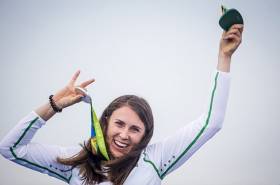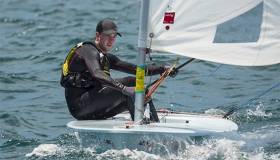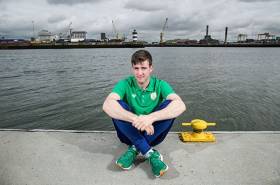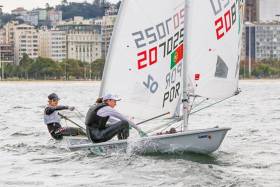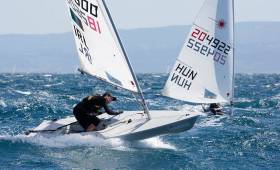Displaying items by tag: Finn Lynch
Irish Sailing Foundation Honours Olympic Hero Annalise Murphy
#ISF - Rio silver medallist Annalise Murphy is now an honorary member of the Irish Sailing Foundation (ISF) following her incredible Olympic success this past summer.
The announcement comes as the ISF, the new investment support structure for Ireland’s high performance sailing programme, celebrates a year of achievement at every level of competition.
Indeed, Murphy’s medal win wasn’t the only result for Irish sailing in August, with fellow Team IRL members Ryan Seaton and Matt McGovern making their medal race in a final hurrah before their recent split, Andrea Brewster and Saskia Tidey just missing out on their skiff final, and Finn Lynch putting in a strong performance as the youngest in his class in preparation for a medal challenge at Tokyo 2020.
Beyond the Olympics, August was a good month for Johnny Durcan, Fionn Conway and Ronan Walsh, who took second, third and fourth places respectively in the UK Laser Nationals, while Johnny’s twin Harry Durcan, with Harry Whittaker, won the UK 29er Nationals in Torbay, and Tom Higgins sailed the first Irish boat to win the Volvo Gill Optimist National.
Earlier in the summer, there was success for Ireland’s girls in the Topper Worlds at Ballyholme, as Sophie Crosbie, Ella Hemeryck and Jenna McCarlie claimed the podium from gold to silver in that order, though the boys didn’t fare too badly either, with Michael Carroll in fourth and Jack Fahy sixth.
Elsewhere, at the Laser Worlds in Dublin, Nicole Hemeryck — sister of Ella — placed seventh in the U19 girls competition, while Ewan McMahon was second among the boys. Nicole was also second in the under 19s( 13th overall) at the under 21 worlds in Kiel, Germany.
And even earlier in the year, there was a bronze medal for Dougie Elmes and Colin O'Sullivan at the ISAF 420 Youth Worlds in Malaysia, the first ever podium for Ireland in that competition.
Currently all development teams in the Laser, Laser Radial and 49er have moved to Cadiz to escape the cold ahead of January’s annual World Cup in Miami, with further training camps to follow in Spain and Malta in February and March.
But the year isn’t over yet, as Ireland will be represented by Nicole Hemeryck and Johnny Durcan at the Youth Worlds in New Zealand from 14-20 December.
Looking at the longer term, ISA performance director James O’Callaghan will be on hand at a Performance Pathway information meeting at the Royal Cork this Wednesday 30 November where he will discuss, among other things, the results of his recent fact-finding mission to Tokyo.
O’Callaghan was gathering intel on the sailing venue at Enoshima with a view to Team IRL establishing an early base there — identified as one of the keys to Annalise’s medal finish this summer. That will be especially important at Tokyo 2020, where temperatures and humidity will be significantly higher than they were in Rio.
#Rio2016 - The mother of Irish Laser Olympian Finn Lynch nearly missed seeing him in Rio after failing to secure tickets through the official Irish supplier that's become embroiled in controversy in recent days.
The Irish Times reports on Grainne Adams' interview with Newstalk Breakfast, in which she explained how after great difficulty in contacting Pro10 Sports Management in the run-up to the event, she resorted to a Norwegian ticket resale website in order to attend the opening ceremony earlier this month.
Adams also said that despite the special ticket scheme for friends and family of Olympic athletes, Pro10 told her they did not have tickets for any events in the Olympic sailing regatta, in which Lynch finished a respectable 32nd as he preps for a stronger challenge in Tokyo in four years' time.
As previously reported on Afloat.ie, an allocation of unused official tickets for athletes' families and friends was seized from the Olympic Council of Ireland's (OCI) offices at the Olympic Village in the ongoing Brazilian police investigation into alleged ticket touting.
OCI president Pat Hickey was arrested in his hotel last week on a number of charges related to the illicit resale of Olympic tickets, while other OCI members have have their passports, phones and computers seized pending questioning.
Hickey is reportedly sharing a cell in Rio's Bangu Prison with THG Sports director Kevin Mallon, who was arrested on Friday 5 August in possession of hundreds of tickets for high-profile Olympic events.
Annalise Murphy has sailed another exceptional race in the the top ten of the Laser Radial fleet in Rio this afternoon. The Irish medal hope moved progessively up the fleet in shifty conditions from eighth to seventh. On the final upwind leg the Dubliner moved in to fifth position within striking distance of fourth.
The race started in light patchy winds and then built to a 12–knot hiking breeze on the Ponte course.
On the final downwind leg the order was HUN, CHN, BEL, DEN and IRL.
In another huge result for the National Yacht club star, Murphy, wearing the red jersey to indicate her third overall position after two races, overtook the much faniced Dane Ann Marie Rindom on the short reaching leg to the finish to clinch fourth.
Mária Érdi of Hungary was the race winner followed by BEL, CHN and then IRL.
Following yesterday's race win, It's another very impressive result for Murphy in a consistent performance so far in her 37–boat fleet. It's almost certainly going to be a counter in the best of ten–race series this week.
Race four follows this afternoon. No overalls available. The wind has slowly swung from SE to SW. There is a bit more wind on the Ponte course than the other two. Up to 12 knots at times.
![]() The live tracker facility showed Annalise Murphy well placed in race three of the Radials in 14 knots of wind
The live tracker facility showed Annalise Murphy well placed in race three of the Radials in 14 knots of wind
4th Place in Race 3!! HUGE RESULT!! #COYGIG
— Annalise Murphy (@Annalise_Murphy) August 9, 2016
Rio Storm Before Olympic Sailing Starts, Moderate Winds for First Laser Races Forecast
As Irish Laser sailors Annalise Murphy and Finn Lynch, both of the National Yacht Club, prepare for their first race of the Olympic regatta later today, the Olympic sailing venue saw 40 knots of wind blast out of nowhere and hit the sailing race track from the south-west. With sand whipping across Flamengo Beach, it was an eye-watering reminder that in Rio, you really do have to be prepared for anything. An Angolan 470 ventured out for some high-wind practice, but no one else was showing much interest. With less than 24 hours before the RS:X Men and Women kick off the Olympic Sailing Competition, along with the Laser and Laser Radial, this was not the right time in the four-year cycle for putting bodies and equipment in jeopardy.
Chang Hao is representing Chinese Taipei in the RS:X Men. "My plan was to go sailing today but the wind was too strong so I am just relaxing. I'll set up my equipment and go back to the apartment and take some rest. My first Olympics was 2008, when I was 17. This is my third Olympics, so I'm getting old. But I hope I can go to five Olympics, that's my dream. This time the sailing is close to the city, which is great. I hope i can go and watch other sports, the rugby, the cycling maybe.”
Later on in the afternoon the breeze dropped away to almost nothing. The calm after the storm. The forecast for Monday and the first day of competition looks favourable, with moderate winds and sunny skies on the cards. It could be a perfect way to get things started and calm the nerves after all the tension, the hype and the build-up to this hotly anticipated contest. For local fans in Rio, they will be watching Robert Scheidt open his campaign in the Laser. Can the poster boy (aged 43) of Brazilian sailing write a new chapter in Olympic history and win a record sixth medal?
Meanwhile, there are those looking to make their first mark on the Olympics, such as Alisa Kiriliuk, helming Russia's entry in the women's 470. "This is my first time at the Games but I am not too nervous. My father, Andrei, went to three Olympic Games in the Laser, Soling and Tornado. He is helping me very much. His message to me is: Don't be afraid, just smile, relax, have fun and do what you normally do.”
Arantza and Begoña Gumucio have been sailing together for most of their lives and now the sisters are sailing for Chile in the 49erFX. "It's incredible to be at our first Olympics, and we are loving every moment,” said Arantza. Begoña chimes in, "We're staying in the Olympic Village, sharing a room and soaking up the atmosphere. And when we're out on the water, the local fisherman shout out 'Chile, Chile!' This feels like a home Games for us, we have the South American connection with our friends in Brazil, so we are going to enjoy this a lot.”
For most teams, the first race can't come soon enough. The Nacra 17 fleet, however, is one of the last to start. One team that might be happy about that is the Greek duo of Sofia Bekatorou and Michalis Pateniotis. "We have been sailing together as a team for just four months, so we are still in our honeymoon period,” said Bekatorou of her young partnership with Michalis Pateniotis. Every moment on the water counts for the Greek duo who are being coached by Anton Paz, winner of a gold medal in the Tornado catamaran for Spain, at the 2008 Games. Bekatorou won gold in the 470 at Athens 2004 and bronze in the Yngling at Beijing 2008. Pateniotis has yet to win an Olympic medal. "Working with Sofia it is easy to see how she has achieved so much in her career,” says Pateniotis. "When she sets a goal, she goes all out to get it. We would have liked more time to get ready but we have worked hard for the short time we have been sailing together. We are as ready as we are going to be now.”
Giles Scott was good enough to win a medal four years ago at London 2012. But the Briton had to bide his time as Ben Ainslie was selected for his fifth Olympic Games. Great Britain has won the gold medal in the Finn going back to Iain Percy's victory in Sydney 2000, so there is a sense of expectation around Scott, the four-time World Champion. "For me this moment has been a long time coming, a long old road. In a way it's odd to be so close to it. We've done a lot of hard work to get to this point, and now I just want it to get started. I've done as much research as I can into what to expect, talking to people who have been to the Games before. As of now, it's been how I expected, with more media interest, the measurement and so on, but it feels quite comfortable. Today we have seen a lot of wind. It's a reminder that you could easily have two weeks of no wind and you could easily have two weeks of 20 knots, so you really do have to be ready for everything.”
No matter how much people tell you to try and treat the Olympics is 'just another regatta', Annette Viborg of Denmark believes it's just not possible. Sailing with Allan Norregaard in the Nacra 17 Mixed Multihull, Viborg commented, "The Olympics is even more crazy and mad than I expected. The regulations say that you can only go training at certain times. Everything is very tensed up before the Games. But we know that it's time to bring it on. Game time.”
Reportage by Andy Rice - World Sailing
Results / Entries
A full list of sailors racing at the Rio 2016 Olympic Games is available to view here. Results will be available on World Sailing's Olympic Website when racing starts on Monday 8 August here
Live Tracking
The racing will be available to watch in 2D and 3D via the live tracking. Live tracking will be available when racing commences here
Live Tracking via the Sailviewer-3D Tablet App will be available for devices with 7" or greater screens.
Click here to download the iOS Application
Click here to download the Android Application
www.sailing.org/olympics/
Ireland's Sailing Olympians Deserve Serenity In Their Cocoon
Ireland’s six sailing Olympians have reached their selections for the 2016 Games at different times. Some have been secure with their places for many months, while others have been confirmed more recently, with the final place being filled on May 18th. Now, if all goes according to plan, for the next six days they’ll be at some remove from the petty hassles of everyday life, safe in a cocoon of mental and physical security as the clock ticks steadily on towards their appointment with destiny. The official opening of the 2016 Games is in Rio de Janeiro next Friday (August 5th). Then for the ISA squad, it’s into practice races and the start of the Sailing Olympiad on Monday August 8th. W M Nixon takes an overview.
The Olympic Games are very important for Irish sailing. Some would say disproportionately so, while a few contrarians might even argue that, as a vehicle and equipment sport as much as a physical pursuit, sailing is questionably Olympian in the first place, and certainly not mainstream.
Perhaps. But for a specialist sport like sailing, the Olympics provide a unique four year opportunity to be in the national and international limelight. Over the years, we’ve learned that an Olympic Medal – or even the prospect of one - is a matter for general interest and celebration regardless of how the sport in question is perceived by the general public at home.
Like it or not, the Olympics simplify it all. And the value of winning a medal, even the most modest one, is almost beyond quantification. But at the very least, if at the Olympics you put in an honourable performance, clearly give of your very best, do your uttermost as part of a warm human story, then your sport’s feelgood factor rises to provide new levels of interest and tangible support at official level.
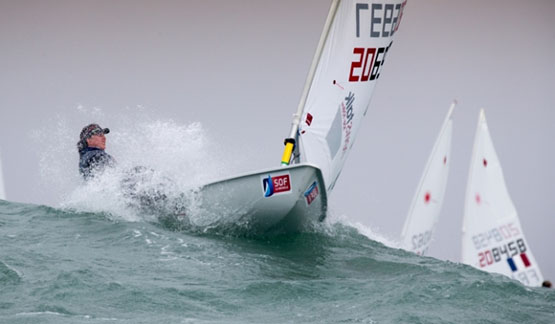 The Olympics may reduce sailing to its basics, but when a medal seems a possibility – as for Annalise Murphy in 2012 – suddenly our specialist sport comes centre stage at national level
The Olympics may reduce sailing to its basics, but when a medal seems a possibility – as for Annalise Murphy in 2012 – suddenly our specialist sport comes centre stage at national level
But how can Olympic sailing project itself as something of particular human interest? It’s simple. People want a people story, and while sailors will happily discuss the minutiae of boat design, sail shape and equipment structure for hours on end, Joe and Josephine Public think a boat is just a thing, and an odd, often wet, and uncomfortable thing at that. They want a human story with which they can identify, and if they don’t get that human story - and quickly – their interest will immediately move elsewhere, for there’s any amount of ready distraction in today’s world.
Time was when the Olympics were about catering for the needs of the athletes, but now the demands of an instant global audience dictate everything. And time also was when the sailing Olympics had at least as many keelboat classes as it had dinghies, and the venue was selected at locations sometimes hundreds of miles from the hosting city in order to provide “ideal” sailing conditions.
But in this age of cities, the demands of the glamour city dominate, and if the host city happens to be picturesquely beside the sea, then that’s where your sailing will be, regardless of the effect of a steep coastline and high buildings on the winds of the race area.
As for keelboats in the sailing Olympics, forget it. Ballast keels reduce the need for athletic capability. And forget individuality and a sense of ownership in boats. Today’s Olympic sailing ideal is exemplified by the Laser, with anonymous newly-manufactured utterly standard boats, sails and masts allocated only days before the event, thereby making the athleticism and ability of the sailors the paramount factor, rather than having any technological edge in boat and equipment.
This paring-back of our beloved sport means that the inevitably ageist structure of the modern Olympic sailing team is not at all representative of the true overall picture of modern world sailing, with its themes of a Sport for Life, and Love Your Boat. With our global spread of 143 different boat classes entitled to hold a world championship, sailing is something of a mystery for the rest of the world. Yet it’s only with the artificially-imposed simplicities of Olympic sailing that we get a chance to explain what it might be about.
Or more accurately, we get a chance to see how the general run of journalists respond to sailing. For it’s only with the very big things of popular interest like the Olympics and maybe the America’s Cup, and perhaps disaster stories like the Fastnet Race of 1979, that your solitary sailing journo gets to rub shoulders with other journalists. So when the ISA staged a Press & Radio Conference this week for the media to meet and question the 2016 Olympic Sailing squad, we went along not to ask questions ourselves, but rather to hear what sort of questions these inquiring representatives of the outside world would ask about sailing.
It’s ironic, but once upon a time it was thought that yachting reports should really appear in the social and gossip pages rather than in the sports pages. Yet today, thanks to its involvement in the Olympics with that nationally-electrifying almost-Medal of 2012 and the ever-increasing emphasis on human stories, sailing is now accepted in Ireland as a proper sport.
 Once upon a time, it was thought that sailing was best reported in the social and gossip pages...
Once upon a time, it was thought that sailing was best reported in the social and gossip pages...
But the reality beyond that is that all sports, sailing included, are now being reported with the emphasis on the human angle rather than on the athletic and technical issues, though of course good old-fashioned winning is still paramount. But as for how that win is achieved – well, open any sports section of a print newspaper (remember them?) and most of the photos will be of people, frequently in facial close-up and showing extreme reaction to some incident or achievement which is of itself so incidental that it is seldom illustrated.
Thus we’re getting to the stage that serious newspapers are veering away from carrying anything like old-fashioned social diaries. Today any event – whether it be a sports championship, company annual general meeting, or a major political announcement – is reported as though it belongs in the social diary, becoming just another happening in the daily progress through the world of the nation’s social life.
So although Tuesday’s press conference made token gestures of getting to grips with how our youngest Olympic sailor Finn Lynch seems to do all his main training in Croatia, and whether or not Annalise Murphy has been made ill by the fact that she has put in significant time during the past three years training in the polluted waters of Rio de Janeiro (she hasn’t), really what the press corps wanted was human stories based on past events to which their readers could relate, and happily for Irish Olympic sailing, our team could come up with the goods.
Thus next morning’s papers came up with a story in the general news pages about how Saskia Tidey continues to draw inspiration from her 81-year-old kidnap-surviving dad Don, while another paper had the sports pages telling of how Annalise Murphy came within a whisker of winning the Bronze in 2012, but then came to terms with it, put it behind her, and went into the dedicated count-down towards Rio 2016.
 Andrea Brewster and Saskia Tidey, 49erFX Olympic crewAs for the 49er guys from the north, Ryan Seaton & Matt McGovern, they provided oodles of copy about just how they’ve managed to stay together for so long to such an extent that you could see a spectral “The Odd Couple” sign hovering over them during their part of the show.
Andrea Brewster and Saskia Tidey, 49erFX Olympic crewAs for the 49er guys from the north, Ryan Seaton & Matt McGovern, they provided oodles of copy about just how they’ve managed to stay together for so long to such an extent that you could see a spectral “The Odd Couple” sign hovering over them during their part of the show.
And then to give everyone a warm community feeling, we’d the real page-turner of how Finn Lynch of Bennekerry in County Carlow comes to be the youngest sailor in Ireland’s Olympic squad. As the details of that were teased out, we may have learned more about the GAA in Bennekerry and the little sailing club in Blessington than we did about the Laser in Rio. But if the purpose of Tuesday’s gathering was to give Irish Olympic sailing a friendly and responsive human face, then Finn Lynch and his team mates have won gold in the social stakes already.
 Profoundly rural – Finn Lynch’s home county of Carlow
Profoundly rural – Finn Lynch’s home county of Carlow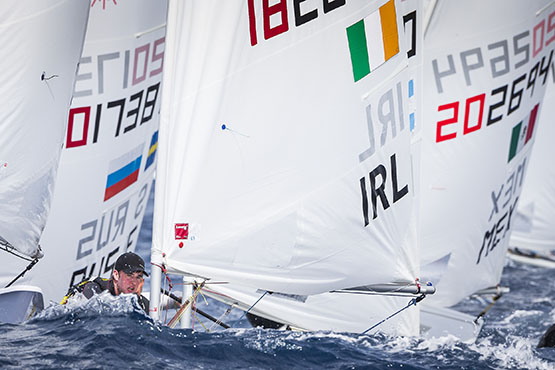 The Young Man and The Sea – Finn Lynch takes the Olympic Laser place in Mexico on May 18th
The Young Man and The Sea – Finn Lynch takes the Olympic Laser place in Mexico on May 18th
Their boats? At the conference, boats were very quickly shunted aside in the pursuit of human stories. Boats are trouble enough to comprehend, sailing boats are double trouble. The problem with sailing boats is sails. Mysterious sails harnessing the invisible wind can make the straightforward fact of Olympic participation into something very weird.
With rowing, by contrast, you may have boats, yet it’s so obviously sheer athletic prowess which brings rowing success. But sailing? For sure, athletic ability, training and coaching are more important than ever. But sails and the wind remain firmly in the region of the sacred mysteries. Thus far from trying to group sailing together with rowing and swimming as water-based sports, it’s arguable that the only Olympic area which shares a unique complexity with sailing is equestrianism, for a sailing boat can seem as much of a living thing as a horse.
So how are our sailors of the sea horses going to do in Rio? As Annalise Murphy has more experience of the venue than anyone else, her opinions were of special interest. She crisply dismissed any grumblings about the flukiness of the sailing waters by saying that the unpredictability is so general in sailing in Rio’s winter (or what passes for winter when you’re near enough to the equator) that in the end it’s the same for everyone.
Certainly she’s giving it her best shot, and she has benefitted – as have all the Irish sailing squad - from the involvement (intensive in her case) of uber-coach Gary Keegan of the Institute of Sport. He’s leaving the Institute for a new venture after the Olympics, but for now, he has helped guide Murphy to peak form, thanks to a closely-controlled weight reduction programme as part of a carefully-monitored training plan which, at Tuesday’s conference, had the Irish sailor looking extremely fit and well, with her mental outlook in a very good place.
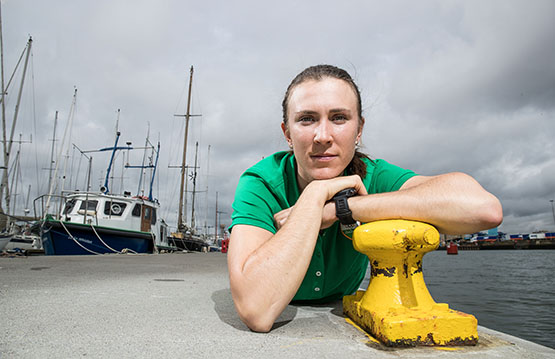 Annalise Murphy in thoughtful mood on Tuesday. Photo: Dan Sheridan/INPHO
Annalise Murphy in thoughtful mood on Tuesday. Photo: Dan Sheridan/INPHO
Inevitably the new-look Murphy has to be the most likely medal prospect, for despite her significant height, she’s certainly rated as a contender by her peers. Of the rest of the team, the two 49er guys have shown they can do it, they won the gold in Palma in April but have been erratic since, yet with the selected nature of the Olympic fleets, they could well be on the money.
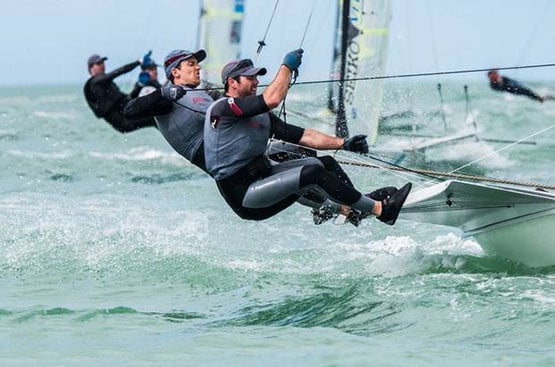 Ryan Seaton and Matt McGovern keeping busy
Ryan Seaton and Matt McGovern keeping busy
Andrea Brewster and Saskia Tidey on the women’s skiff made it into the Olympic qualification by the skin of their teeth, but if a sporting outlook and gallant determination are keys to success, then their showing will have an added interest.
While the rest of the team have been on the scene for a while, Finn Lynch is the new kid on the block. But despite only turning twenty back in April and then not getting his Olympic qualification until May, he has been maturing before our very eyes ever since he started this particular journey a year ago.
The Finn Lynch story just builds and builds, for not only is he the youngest member of the Irish sailing team by far, but he is competing in the most numerous class as the Lasers will be mustering 46 boats at Rio. And he will find himself racing in the distinguished company of one of the most popular sailors in the world, Brazil’s legendary Robert Scheidt, who at 43 will be the oldest competitor in the Sailing Olympics 2016.
There are great stories already there. And there could be some mighty stories in the making. As ISA Performance Director James O’Callaghan put it, it may be very much an outside shot, but we might even be due a medal. Either way, our dedicated Olympic squad – sailors and coaches alike – have brought sailing centre stage in the Irish consciousness for the next three weeks. But for now, they’re very deservedly in seclusion even if, in the outside world, the rumour mills will inevitably grind on.
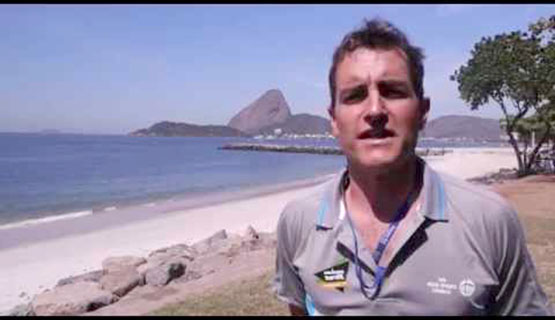 ISA Performance Director James O’Callaghan in Rio de Janeiro
ISA Performance Director James O’Callaghan in Rio de Janeiro
The Rio 2016 One Person Dinghy (Laser) fleet will welcome a bumper 46 boats, making it the largest fleet at the Olympic Games.The youngest competitor of all the Laser helmsmen will be Ireland's Finn Lynch, a 20–year–old so fast-tracked that only a few months ago he was sights were not on Rio but aimed squarely at a Tokyo 2020 place. Here's a taste of what the young Carlow sailor can expect next month in the hottest of Rio's sailing fleets.
When racing starts on Monday 8 August at 13:00 local time on the Escola Naval course, a large percentage of the racers will start with high hopes and great expectations.
Laser sailing will see some of the closest, compact racing of any of the Olympic fleets with each sailor receiving a supplied boat, ensuring an even playing field. With races scheduled for inside and outside Guanabara Bay, it will see the best all-round sailor conquer.
2015 and 2016 World Champion Nick Thompson (GBR), London 2012 silver medallist Pavlos Kontides (CYP), World #1 Philipp Buhl (GER), World #2 Tonci Stipanovic (CRO) and 2015 Olympic Test Event winner Francesco Marrai (ITA) will all be major contenders.
However, there is one name on the list of athletes that shines brightly and has achieved more than the entire fleet put together.
Stand up, Brazil's own Robert Scheidt, one of his country's most successful Olympians who will carry the hopes of his nation on his shoulders at Rio 2016.
Scheidt is bidding to become the most decorated sailor in history by winning six consecutive medals at six Olympic Games. In fact, this feat, in any sport, has only been achieved once by Hungarian swordsman Aladar Gerevich who won medals at six consecutive Olympiads from 1932 – 1960.
Scheidt won gold in 1996 and 2004 as well as a silver in 2000 in the Laser. He moved into the Men's Keelboat (Star) after Athens 2004 and won silver in 2008 and bronze in 2012. He stepped back into the Laser in 2013, winning the World Championship for the ninth time.
At 43, Scheidt will be the oldest competitor in the Laser fleet and has signified that the 2016 Olympic Games will be his last. Racing in his home nation, in front of a partisan crowd, Scheidt has an opportunity to engrave his name into Brazilian sporting history for the perfect send off. The 46-boat fleet only includes one other Olympic medallist, and in the pressure pot of Olympic sailing, Scheidt knows how to reach the top.
"The fire, for sure, keeps burning,” explained Scheidt, "I would really like to get one more medal and I think the mental part is really important at the Games because the pressure is huge.
"Everybody knows they only have that week and that one shot. I'm in a pretty comfortable situation because I've already medalled five times. I've done all of that. The experience counts a lot and I think I am going to be able to be mentally strong at the Games which will be an important thing.”
A sailor's mentality at an Olympic Games is vital. Tom Slingsby (AUS) entered the Beijing 2008 Olympic Games as overwhelming favourite in the Laser but things did not go his way. Four years on, older and wiser with Olympic experience behind him he won gold at London 2012.
Great Britain's Paul Goodison was in with a shot of a medal at his first Olympic Games, Athens 2004, but narrowly missed out. Four years later, at Beijing 2008, he stormed to gold.
With Scheidt's 'I know how to get it done' attitude, he can be considered a favourite, especially as strong, leading contenders like Great Britain's Thompson, Australia's Tom Burton and Italy's Marrai, who all have various accolades, will be sailing at their first Olympic Games.
Apart from Scheidt, only Cyprus' Kontides holds an Olympic medal in the Laser fleet after he picked up silver at London 2012, which was in fact his nations first ever Olympic medal. Rio 2016 will be Kontides' third Olympic Games.
Further contenders include Julio Alsogaray (ARG), Jean Baptiste Bernaz (FRA), Juan Ignacio Maegli (GUA), Rutger van Schaardenburg (NED), Sam Meech (NZL), Jesper Stalheim (SWE) and Charlie Buckingham (USA).
The Laser will start racing on Monday 8 August at 13:00 local time on the Escola Naval racing area.
Previous Olympic Medallists
The first ever Olympic medal in the Laser was won by Brazil's Robert Scheidt at the Atlanta 1996 Games after a dramatic start line duel with British rival Ben Ainslie. Sydney 2000 saw Ainslie's revenge, as the Brit match raced the Brazilian for the Gold. Following Ainslie's switch to the Finn for the Athens 2004 quadrennial Robert Scheidt dominated the class and ultimately made a triumphant return to the top of the podium - his second Olympic Gold medal. Scheidt then switched classes to the Star, leaving another Brit, Paul Goodison, to take Gold at Beijing 2008. London 2012 saw a long-awaited gold for Australia, after years of strong Australian performances Tom Slingsby was finally able to capture the top step for the boxing kangaroos.
Recent World Champions
The Rio 2016 quadrennial kicked off in Oman where Robert Scheidt (BRA) announced his return to the Laser in style by taking his ninth Laser World Championship title. Nicholas Heiner (NED) won in 2014 but the Rio 2016 quad was really dominated by Nick Thompson (GBR) who took third place in 2014 and followed it with back to back World Champion titles in 2015 and 2016.
Life as an Olympic Event
The Laser never fails to deliver drama to proceedings. Five Olympic sailing competitions have seen it all; fierce rivalries, winner-takes-all match racing, surprise upsets, Olympic firsts and of course some of the closest racing on the Olympic sailing program.
The Laser was introduced to the Games as an open class for the 1996 Quadrennial. The simple single-person dinghy already had a cult following of thousands all over the world and inclusion was almost viewed as a forgone conclusion. In 2004 the Laser was changed to from open to men's lightweight equipment following the inclusion of the Laser Radial as women's single person dinghy for the 2008 cycle.
The Laser's low cost means it has the widest pool of nations competing of any Olympic Sailing Class and it's not unusual to see sailors from nations that aren't traditionally viewed as big sailing nations on the podium.
What's it like to sail?
Deceptively simple. The Laser is known as a boat that's easy to sail badly. Laser sailing and racing presents a unique set of physical and skill based challenges. At the top level it's a physical class, requiring a very high level of core fitness in order to endure the hiking and body-torque techniques essential to get the boat moving fast.
Short History of the Class and Key specs
The Laser is a 4.19m long, 56.7 kg hiking dinghy with a single 7.06 m2 sail. While not the most high performance class at the Games the Laser probably has the most enthusiastic following.
The Laser's story began with a phone call between Canadians Bruce Kirby and Ian Bruce. A marketing offshoot of Canada's Hudson Bay Company had asked Bruce to come up with proposals for a line of outdoor sporting equipment, among them was a boat small enough to be carried on a roof rack of a typical car. As they talked Kirby sketched what would be known as "the million dollar doodle". The now famous sail was the brainchild Hans Fogh who originally designed it without sight of the rest of the boat. Fogh would go on to tweak his design before finally settling on the rig that we know today.
The sailboat idea was ultimately dropped and the drawing remained in Bruce's drawer for several months until One Design and Offshore Yachtsman magazine held a regatta for boats under $1000 which Kirby and Bruce saw as the perfect opportunity to launch their little dinghy. With some overnight modifications the prototype that would become the Laser won its class.
After more tweaking the first official Laser was officially unveiled at the New York Boat Show in 1971. The class took off immediately. The first world championship was held in three years later in Bermuda. Entrants came from 24 countries, and first place was won by Peter Commette (USA). The Laser was included in the Olympic roster for the first time for Atlanta 1996 quadrennial and has remained an Olympic Class ever since.
Today more Lasers have been sold than any other type of boat - well over two hundred thousand of them! The simplicity and low cost of the design means Lasers can be found everywhere from the Olympic Games to the beach in front of your hotel on holiday. The biggest attraction of the Laser dinghy is that it is protected by strict one-design class rules, which means each Laser is built to the same specifications and modifications to boats are strictly prohibited. This means every boat is virtually identical which leaves it down to the skill of the sailor to win the race.
Famous Faces
Arguably the greatest champion of the Laser Class is Robert Scheidt from Brazil with two gold and one silver Olympic medals and nine Laser World Champion titles. Only two other sailors can claim more than two Laser World Champion titles; Tom Slingsby (AUS) has five and fellow countryman Glenn Bourke, three. Scheidt's fierce rivalry with Sir Ben Ainslie (GBR) is the stuff of legend. The Brazilian master will be aiming for his third medal on home waters in Rio when the games kicks off in just a few days' time.
On the Rio start line, Scheidt will be joined by a colourful cast of talented athletes, vying for their place on the podium. Pavlos Kontides (CYP) - whose silver medal in London was Cyprus's first ever - will be looking to go one better. Philipp Buhl (GER) and Ton?i Stipanovi? (CRO) who are never far from the podium will both be looking to add Olympic medallist to their impressive sailing CVs.
The Laser has also been home to big names in the sailing world like Ed Baird (USA), Nik Burfoot (NZL), Gustavo Lima (POR), Michael Blackburn (AUS), Mark Mendelblatt (USA) and Vasilij ?bogar (SLO).
Did you know…
The Laser was originally named the "Weekender" with the Prototype sail branded with the letters TGIF for "Thank God it's Friday". It was renamed Laser following a suggestion by student Doug Balfour who pointed out that the name 'Laser' was modern, recognizable and truly international and that the symmetrical Laser beam logo would only have to go on one side of the sail. The rest is history!
Reporting by World Sailing
Irish Olympic Sailing Team Profiles for Rio
The chances of winning an Olympic sailing medal next month, have been described by Team manager James O'Callaghan as an 'outside shot'. Can Ireland's four boat Irish Olympic Sailing Team deliver on the 36–year medal drought? Afloat.ie gives its assessment boat by boat
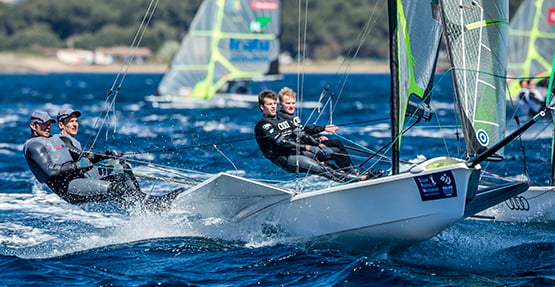 Belfast Lough's Ryan Seaton and Matt McGovern start racing in Rio on August 12
Belfast Lough's Ryan Seaton and Matt McGovern start racing in Rio on August 12
49er – Ryan Seaton & Matt McGovern
Ryan Seaton and Matthew McGovern have been steadily working their way up the world rankings this year, from 22ncd at the start of the year to 11th in the latest version. These London 2012 veterans (14th) have put in some stellar performances in recent months, most notably winning the Princesa Sofia Regatta in Palma in April.
Seaton and McGovern qualified Ireland at the first possible opportunity at the combined World Championships in Santander in 2014, finishing 8th. But their performance since has been erratic and the win in Palma was bookended by a 37th in Miami and a 28th at the 2016 Europeans. Most recently, at the international sailing week in Rio, the Belfast pair finished down the fleet, but may have been using this regatta for testing or training purposes.
There is no doubt, that on their day, Seaton and McGovern can compete with the world's best.
Men’s Skiff (49er) 20 competitors Race duration: 3 x 30 minutes daily (medal race 1 x 20 minutes) Competition days: Fri 12th/Sat 13th/Sun 14th (Reserve)/Mon 15th/Tue 16th/Wed 17th (Reserve)/Thu 18th - medal race/Fri 19th (Reserve)
 Dublin Bay's Andrea Brewster and Saskia Tidey start racing in Rio on August 12
Dublin Bay's Andrea Brewster and Saskia Tidey start racing in Rio on August 12
49erFx – Andrea Brewster & Saskia Tidey
Andrea Brewster and Saskia Tidey were the last of the Irish team to qualify, enduring heartbreak at the 2015 worlds where they were denied qualification by a protest in the final race report here. However, their performance at the Worlds was good enough to secure the next available place a few months later when no team from Africa emerged. Story here.
Brewster, a product of the British Olympic Laser radial squad, and Tidey, who transitioned from the Radial to the 49er following a season racing 18ft Skiffs in Sydney, have, until this year, hovered in the early 20s in world ranking and results at major events. 2016 has been something of a breakthrough for the Royal Irish duo, finishing in the teens more consistently, including a 12th at the European championships in Barcelona in April. A final day scoreline of 2,1,3 shows the potential that resides in this team.
Women’s Skiff (49erFX) 20 competitors Race duration: 3 x 30 minutes daily (medal race 1 x 20 minutes) Competition days: Fri 12th/Sat 13th/Sun 14th (Reserve)/Mon 15th/Tue 16th/Wed 17th (Reserve)/Thu 18th - medal race/Fri 19th (Reserve)
 Dublin Bay's Finn Lynch starts racing in Rio on August 8
Dublin Bay's Finn Lynch starts racing in Rio on August 8
Laser – Finn Lynch
Finn Lynch's fairytale journey to Rio is recounted in Sailing on Saturdays by Winkie Nixon. However he had to overcome the 2012 Olympian James Espey, who's 38th place at the 2014 world Championship in Santander qualified the country. ISA imposed a three regatta trials system, starting with the Copa de Brasil regatta in Rio in December 2015, where Espey shaded Lynch by one place. At the next event in Palma in March and April, neither sailor made gold fleet, but Espey increased his advantage with a 53rd to Lynch's 58th. Going into the final trial, the 2016 Laser Worlds in Mexico in May, Lynch had it all to do, but a solid series of consistent results saw him qualify for the Gold Fleet, while Espey never really got off the ground until it was too late.
While Lynch, who's best results have been at under age events, is certainly not a favourite for podium in Rio, his trajectory suggests that a medal in Tokyo in 2020 is well within his capability.
Men’s One-person dinghy (Laser) 46 competitors Race duration: 2 x 50 minutes daily (medal race 1 x 25 minutes) Competition days: Mon 8th/Tue 9th/Wed 10th/Thu 11th (Reserve day)/Fri 12th/Sat 13th/Sun 14th (Reserve)/Mon 15th - medal race/Tue 16th (Reserve)
 Dublin Bay's Annalise Murphy starts racing in Rio on August 8
Dublin Bay's Annalise Murphy starts racing in Rio on August 8
Laser Radial – Annalise Murphy
Currently perhaps Ireland's most famous sailor, Annalise Murphy dismissed the challenge of Aoife Hopkins in the three event trial. However, recent form contradicts her suggestion that she is one of eight in the fleet with the potential to win a medal in Rio. Since January, her results at major events have been 48th (Miami World Cup), 30th (Laser Europeans), 39th (Laser Worlds) and 34th (Weymouth World Cup). The historical profile of light and fickle winds at the Olympic venue suggests that Annalise, a heavy weather specialist, will struggle to make the medal race. The 2013 European champion has, however, surprised on many occasions before and as recently as this month scored an important win on Olympic waters in her last regatta before the Games at the Rio de Janeiro International Sailing Week. Results of that win are here.
Women’s One-person dinghy (Laser Radial) 37 competitors Race duration: 2 x 50 minutes daily (medal race 1 x 25 minutes) Competition days: Mon 8th/Tue 9th/Wed 10th/Thu 11th (Reserve day)/Fri 12th/Sat 13th/Sun 14th (Reserve)/Mon 15th - medal race/Tue 16th (Reserve)
Afloat.ie has charted the progress of the 2016 Olympic sailing team over the last four years in a dedicated Irish Olympic Sailing section
Olympic Laser Ace Finn Lynch Sails From Carlow to Copacabana
The rise of Finn Lynch into the top ranks of Irish adult dinghy sailing has been meteoric. It was as recently as May 18th in Mexico that he secured the right to become our Olympic Men’s Laser representative in Rio, where the first races of the Sailing Olympiad 2016 get under way on Monday August 8th. Yet he had only just turned 20 on April 23rd 2016. W M Nixon sets the scene.
With significant Bicentenaries and Tricentenaries cascading around us these days, Golden Jubilees may not make the same impact as they did back in the 20th Century. Nevertheless an achievement of fifty years of continuous specialised sailing enthusiasm and success is still something to be celebrated at all levels.
In the National Yacht Club next year - if they can find the time in the midst of their usual busy annual programme, which will include an up-graded Dun Laoghaire to Dingle Race - they might like to take an evening out to mark fifty years of their internationally-renowned Junior Sailing. It has become a pace-setter central to Irish sailing, so much so that with the Olympics in Rio de Janeiro just two weeks away, of the four boats in the Irish team, two will be sailed by alumni of the NYC’s Junior Programme – Annalise Murphy in the Women’s Laser Radials, and Finn Lynch in the Men’s Lasers.
Yet we get some notion of the way that the NYC people get on with the business of the day, living and sailing as they do in the moment, that the matter of the Junior Sailing’s Golden Jubilee came up as something of a minor aside. In the midst of a discussion about the spirit of the NYC Juniors, the enthusiastic Carmel Winkelmann simply mentioned in passing that it all really goes back to 1967, when Johnny Hooper came home from a dinghy championship in Scandinavia fired up with enthusiasm about the way the clubs there put so much in the way of resources and energy towards encouraging the juniors.
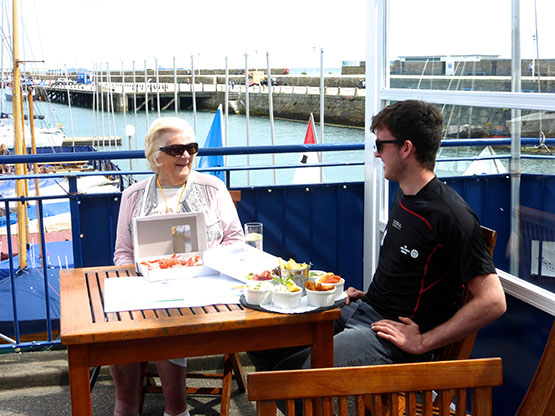
In his quiet but determined way, Johnny Hooper - with his own Olympic credentials and more championship wins than you could list on one page - was able to persuade his fellow NYC members to take positive action for juniors, and continue to keep taking that positive action. For it can be easy enough to start things. It’s keeping the programme going and growing, with rising standards all the time, that differentiates the exceptional setup from the merely run-of-the-mill. The Hooper inspiration has endured and thrived. But it was only when the year of its inception happened to be mentioned that the radar flashed up: Golden Jubilee in 2017.
Regardless of what happens at the Olympics, there certainly will be something to celebrate next year. But for the next few weeks, any notions of such celebrations will be on the most remote back burner, as the entire club - and indeed all of Irish sailing - will be on Olympic high alert.
We’ll share a state of nervous anticipation as the quadrennial five ring circus unfolds afloat amidst the unrivalled beauty and unique sea water quality of Rio de Janeiro. And somewhere in the midst of it all, attention will be particularly focused on the youngest sailor ever to represent Ireland in the Olympic, a 20-year-old from an utterly rural part of County Carlow whose very young demonstrations of special talent soon saw him being inducted into the bigger world of National Yacht Club’s Junior Section, and also provided him – thanks to that special NYC spirit - with essential financial support in the crucial year of moving from junior to adult level.
Finn Lynch at 20 years and three months will not only be the youngest sailor ever to represent Ireland in the Olympics, he’ll actually be a couple of months younger than the notably young Paul Elvstrom of Denmark when he began his stellar career back in 1948, an achievement which set a benchmark for youthful Olympic sailing participation.
 Finn Lynch is welcomed home at the NYC after qualifying for Rio. At 20 years and three months, Finn will be Ireland’s youngest-ever Olympic sailor. Photo: W M Nixon
Finn Lynch is welcomed home at the NYC after qualifying for Rio. At 20 years and three months, Finn will be Ireland’s youngest-ever Olympic sailor. Photo: W M Nixon
But as Lynch only snatched Ireland’s Olympic Men’s Laser place as recently as May 18th on the last race in the last chance in Mexico, the sailing community are still getting to grips with the fact that a rising talent, who had been showing great promise to be the ideal representative in Tokyo in 2020, has already come centre stage to begin his Olympic career in Rio 2016.
The story of how this has come about for Finn is circuitous and distinctly offbeat, yet ultimately very Irish. But if you suggested the outline of it to a movie producer as a possible film treatment, you’d probably be told it’s so over the top that audiences would refuse to accept it. All that can be said is that if it isn’t true, then somebody should make it up, as it’s too good a story to waste.
His father Aidan Lynch is of a midlands family, and though his boyhood was in Dublin, much time was still spent down the country, but boats had absolutely nothing to do with it. His mother Grainne Adams is from rural Carlow, that small county which is so beautiful that it has been rightly remarked the Creator was in fine form when he put it together.
However, neither Carlow nor Dublin offered the young couple the prospects they sought, so they emigrated to Australia. There, Aidan found much better career opportunities, and it was during his time as a rising star in the manufacturing world that he was taken on a corporate sailing outing. He was instantly hooked, and made it his spare-time business to learn about sailing and get involved with it as soon and as much as possible.
In Australia their three sons Ben, Rory and Finn were born, but after twelve years – when Finn was just two – the Australian sojourn came to and end, and Grainne was able to return to her beloved Carlow, to Benekerry which is just about as rural as it is possible get in a very rural county. But Aidan hankered after his sailing, and got involved in the nearest club, Blessington on its lovely reservoir lake just up the road in County Wicklow. In time, Blessington became his home while Grainne continued in Benekerry, and for their three boys, time with Dad saw sailing playing an increasing role. While Ben and Rory were already rising stars in the Blessington Topper sailing scene, it was when Finn had his first sail in charge of a Topper at the age of eight on Blessington Lake that history was made.
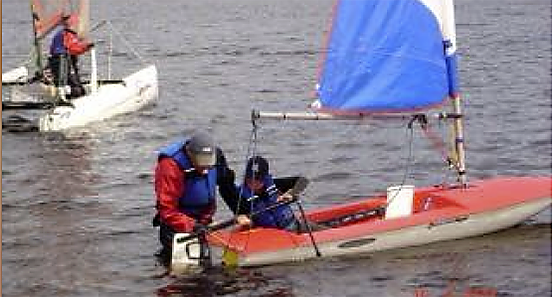 The first sail - his father Aidan introduces the 8-year-old Fnn Lynch to Topper steering in Blessington Lake
The first sail - his father Aidan introduces the 8-year-old Fnn Lynch to Topper steering in Blessington Lake
He’d already shown a complete fascination with everything to do with boats and sailing. Big brother Ben was showing additional talent as a coach, and when he ran classes in the Blessington SC clubhouse, he was at first disconcerted to see his kid brother Finn perched under the front table, bright-eyed and determinedly absorbing every snippet of boat and sailing information that came his way.
Blessington was one of the foremost clubs in the country in promoting the use of the Topper in junior sailing. But although this weekend will see the largest Irish entry ever in the 250-strong Topper Worlds which are getting under way in Ballyholme – last count had the home group pushing toward the 85 mark - only twelve years ago, the economical Topper still had a certain amount of persuading to do in order to get acceptance in Ireland.
Yet those were good times when they were building the class, and Aidan Lynch happily recalls the spirit of camaraderie and shared purpose which energised the steadily growing “Topper family” in Ireland, creating friendships which were rekindled when former Topper colleagues from all over Ireland shared in Finn Lynch’s successes.
For although he may not have started properly sailing until he was eight, in his case it seems to have been the right time, and by the age of 12 in 2008 he had been selected for the ISA Topper Squad in which he developed so rapidly that in 2009 he took the Silver Medal at the Topper Worlds in Austria.
He was still sailing with Blessington, but with the prospect of Laser sailing with the National YC coming up on the agenda, he moved his focus to Dublin Bay and by 2011 was selected for the ISA Academy. The ISAF Youth Worlds in Dublin Bay in 2012 were perfectly timed for his developing talents, where he won the Silver Medal, and added the Under 17 European Laser Radial title to his trophy list, while in 2013 he was Under 21 Laser Radial World Champion, winning the Bronze in the Open Division.
 The Laser might have been designed with Finn Lynch in mind
The Laser might have been designed with Finn Lynch in mind
 Into his stride. Finn Lynch in command, Dublin Bay 2012
Into his stride. Finn Lynch in command, Dublin Bay 2012
The Under 19 Laser World Champion title followed in 2014, while in 2015 he was fourth in the Under 21 Laser Worlds. But now at age 18 he was no longer a junior, yet was very much in that limbo stage in which Irish sailing seems to place talent which is no longer junior, but is still definitely not adult. It’s an undesirable state of affairs, yet with ISA resources under enormous pressure, it was not a problem which was going to be solved by the National Authority in 2015.
The 18-year-old Finn Lynch found himself right at the heart of this dead end, needing backing which was beyond family resources, but in any case frustrated at not being able to make his own way in a true spirit of growing independence. He had impressed everyone with his talent, his coolness under pressure and his sheer dedication to the sport, but a quantum leap in resources was needed to see him across the gap from family support under the ISA junior umbrella, and on into the challenging world of adult sailing based on an adequate budget.
In the Spring of 2015 Carmel Winkelmann, a strength of the National Yacht Club and particularly its junior section for longer than anyone can remember, was already working quietly behind the scenes to find support for what she reckoned was a great talent at risk of going to waste. After consulting with Finn about the events he’d particularly like to do in the year ahead and the international coaches whose talents he’d like to use, it was reckoned that with the most careful expenditure it could be done for €40,000, and that was the target Carmel had set herself by June 2015.

She’s a formidable woman when she thinks a real noise has to be made about some boat issue, but she’s much more formidable when she takes the approach of working quietly behind the scenes to achieve her objective. Her Finn Lynch fund-raising was done under the very sensible approach that good works are best done by stealth, and the money-raising was mainly through a small but impressive list of private subscribers.
I met Finn in June 2015 when there was still a considerable element of the unknown and the unknowable about it all, and then I met him again at the end of June this year when his Olympic place was secured against all the odds, and the story of what had happened in between was in keeping with the extraordinary story of how he and his brothers came to be keen sailors in the first place.
For the past year, his life has been a mobile existence. While Carmel Winkelmann and her team had to come up with all the resources to keep the Lynch show on the road, James O’Callaghan the ISA Performance Director was able to come up with the introductions to the top coaches in Croatia whose special talents fit well with the Irish sailing model. Nevertheless, even with all the support and good wishes being drummed up under the NYC umbrella, it was still a lonely enough existence for the 19-year-old Carlow lad to take himself off to southeast Europe and be the youngest in an intense training squad which lived and breathed Laser racing, but they lived and breathed it in languages other than English.
His first introduction to the notably successful Croatian training programmes was with Milan Vujasinovic, who as Finn recalls, “turned us into sailors and into men”. Then through dogged persistence, and maybe a bit of blarney, he managed to get himself taken into the elite group under the tutelage of the “medals coach”, Jozo Jakelic, who is a legend in the training world.
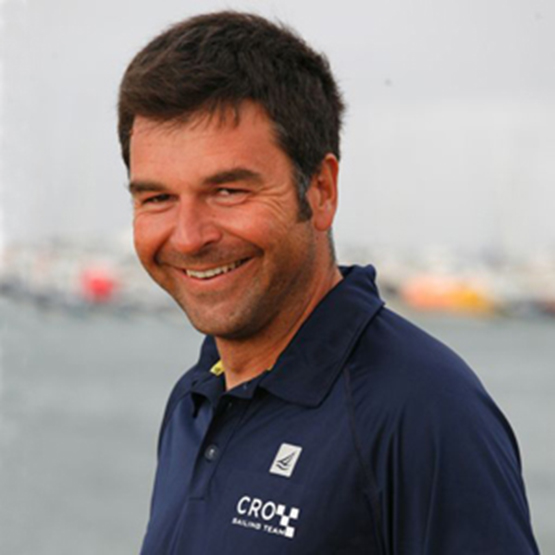 Coach to the stars….Croatia’s Jozo Jakelic has seen all five of his elite international squad gain an Olympic place at Rio
Coach to the stars….Croatia’s Jozo Jakelic has seen all five of his elite international squad gain an Olympic place at Rio
It’s a status he thoroughly deserves, for all of his special squad of five Laser sailors have secured their country’s Olympic places for the Rio games. Jakelic is bringing stardust to countries which would formerly have been thought of as being on the fringes of world sailing, paces like Cyprus and Poland and Ireland too, for let’s face it, despite having one of the longest sailing histories of any country in the world, in international competition terms Ireland is on the fringe.
Thus you could argue that Finn Lynch was on the fringe of the fringe group, for at 19 he was much the youngest of the Jakelic squad – the next up was 25. Yet he kept at it, keeping up a ferocious regime in which, when not in competition, you still expect to be doing a lot of sailing on at least fifteen days in very month, while gym work towards ultimate fitness is just a normal part of life all the time.
 The pressure is on. Finn Lynch during the long battle to secure the Olympic place
The pressure is on. Finn Lynch during the long battle to secure the Olympic place
Yet in this rarefied and almost monastic atmosphere, progress was being made, but there were setbacks. Last November, while out on an intensive session on a training bike, Finn Lynch had an accident which left him with a badly damaged shoulder. At one stage it was thought surgery would be necessary, but thanks to high-powered physio with Sports Med in Dublin, he was just about able to compete, albeit with an impaired performance, at the Copa de Brasil in Rio.
One of his concerns would be that this accident would discourage his group of private supporters. But on the contrary, if anything it spurred them onto to greater efforts and a determination that he would see the programme through to leave him, at the very least, in a good condition and in a good place to begin the serious countdown to Tokyo 2020, buoyed up by the knowledge that an entire year hadn’t been allowed to go to waste.
Certainly for most observers it seemed very much an outside chance that Lynch would manage to take the Irish place through the final qualifier, the Laser Worlds in Mexico in May 2016. But the Finn Lynch who arrived at the Worlds was a different Finn Lynch from the damaged athlete who had been unable to give of his best in Brazil. And he was a whole world away from the still-to-prove himself young adult who had been in Dun Laoghaire in June 2015.
It didn’t start well in Mexico, as he’d picked up a virus which sapped his strength. But he seemed to shake it off through sheer will-power, and put in a performance of almost superhuman focus to do the job. Finn Lynch secured that Irish Laser place in the Rio Olympics in a last ditch stand on May 18th 2016, and it’s no exaggeration to say that at a stroke his lifepath had been changed.
We’ve a problem in Ireland in that getting an Olympic selection is seen as such a goal in its own right that for some athletes, it seems to be the main goal – what happens in the actual Olympics becomes almost irrelevant. But that’s not a mindset which is going to take hold in a member of Jozo Jakelic’s squad, so for a while after the Mexican breakthrough, Finn Lynch chilled out in Norway with his girlfriend and her family (she’s a Laser sailor too) and then spent private time in Ireland – continuing training all the time – until an informal gathering was organized through Carmel Winkelmann. This was in late June at the National YC where the new Olympic star was to meet again with Afloat.ie, and also put through a well-received interview with Clair McNeill of the “Carlow County Matters” magazine programme on Irish TV Sky 191, for in Carlow - even more than in Dun Laoghaire - a new Olympic star is big news.
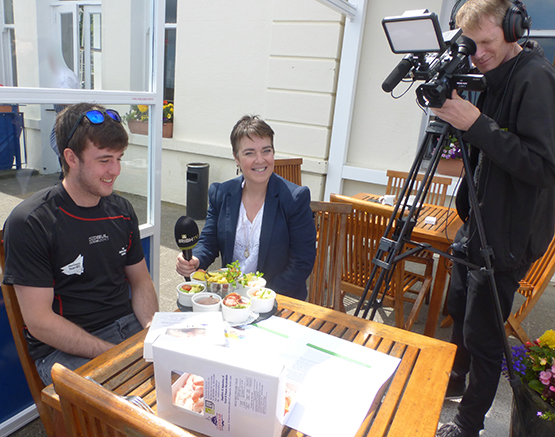
As almost exactly a year had elapsed since I’d met him with his then only resource, a van which might well have served from time to time as overnight accommodation, it was fascinating to try to make comparisons between the more confident young man of today and that much younger hopeful of 2015.
For sure he was more of an impressive and confident presence, but essentially he was still the same Finn Lynch, but with the best bits made even better, and an underlying steely determination now getting towards something even tougher.
But don’t think for a moment that the traiming programme organized through the funding raised by Carmel Winkelmann resulted in him becoming a pampered athlete. There were times when he had to make do with the most basic and often very shared accommodation, while the budget was always tight. But the fact that he was a member of the squad which was the elite of the elites – albeit very much the youngest member of that squad in Croatia – has been transformational.
In a sense it has made him supra-national. The esprit de corps in the Jakelic squad is something which raises pure sailing athleticism above national ambitions and aspirations. Indeed, at a time when the European ideal is taking such a battering, the very existence of such a group made of rising sailing stars from the fringes of Europe is somehow very heartening. Thus the experiences of Finn Lynch during the past twelve months have an added and encouraging resonance for all of us.
Nevertheless, back home the securing of that Olympic place is yet another specific success for the NYC’s Junior Sailing, and Commodore Larry Power and his team treated us to a cheerful bar lunch before everyone went on their way, your reporter off to Wicklow to re-immerse himself in covering the Round Ireland Race, and Finn Lynch soon on his way back to Croatia and further intense yet carefully monitored training sessions to transform him from an aspirant to a contender.
That little gathering in the National YC marked the end of a phase. It quietly concluded Carmel Winkelmann’s fund-raising for Finn Lynch. She was able to provide resources in a hurry when they were urgently needed, and she was able to pass on messages of hundred per cent support from her team when things seemed to be going pear-shaped during the winter.
But now that Finn has shown independently what he can do, it’s time to turn to more orthodox lines of support, and his father has been working behind the scenes to see about putting it all on a more businesslike basis.
Inevitably, just how that all takes shape will depend to some extent on how things go in Rio, but we can only hope that a more mature attitude can be found among the rest of us. Success in Rio would certainly be a bonus, but really we should be thinking about Tokyo 2020, and simply being in contention in Rio is unrivalled experience for Japan in four years time.
Since the end of June Finn Lynch had been back in Croatia, but this week he returned to Ireland to give logistics support to the Croatian squad in the Laser Radial Worlds in Dun Laoghaire. Coaching and encouragement seem to be in the Lynch family blood – after our meeting in June, he’d set that evening aside for a special session of personal coaching for his brother Ben’s training group, and Finn will not be the only Lynch in Rio – Ben is coach to Ireland’s John Twomey and his Paralympic crew. We wish them all the very best of luck. Irish Olympic sailing turns up some remarkable stories, and this is surely one of the most remarkable of all.
Irish Olympic Sailors in Action in Weymouth
All six of Ireland's Olympic sailing team bar one are in action at the final World Cup sailing competition ahead of Rio 2016 gets underway this week in Weymouth this week.
Ireland’s Olympic veterans from four years ago will be first into action on Wednesday morning. The venue is the notoriously windy London 2012 Olympic site though the sailors are preparing for completely different conditions expected in Brazil.
Annalise Murphy in the women’s single-handed Laser Radial event will face all three medallists from her event in 2012 when she narrowly missed a place on the podium. China’s Lijia Xu (Gold) along with The Netherlands’ Marit Bouwmeester (Silver) and Belgium’s Evi Van Acker (Bronze) are all on form but are in turn are joined by challengers such as Britain’s Alison Young, the recently crowned world champion.
Newcomer Aoife Hopkins (18) is also in Weymouth for more competition experience at world-class level after unsuccessfully challenging Murphy for the Irish place in Rio during trials earlier this year but with the radial worlds in Dun Laoghaire in July now the next target.
Ryan Seaton and Matt McGovern in the men’s skiff 49er class will be seeking to make good on their Gold medal performance at the Princess Sofia Regatta in Palma in early April with another podium result to boost their confidence before final training for Rio in August commences. However, four-times unbeaten world champions Peter Burling and Blair Tuke from New Zealand are not expected to compete in Weymouth this week.
The women’s skiff event makes its debut with the 49erFX class at Rio 2016 and Ireland’s Andrea Brewster and Saskia Tidey are aiming to build on recent strong individual race performances at recent major regattas following an injury-enforced break at the start of the year. The pair will be using this week’s regatta to improve consistency across their series with the aim of reaching the medal race final.
Absent from Weymouth is Finn Lynch, the 20-year old rising star of Irish performance sailing who recently won a three-way selection trial to be nominated for Team Ireland. His event in Rio is the men’s single-handed Laser standard class and the Carlow native is currently at a three-week training camp in Croatia. Inclusion in the Irish Providence squad for Rio 2016 marks the high-point of an eight-year career that to-date includes world and youth titles.
268 boats from 40 nations are taking part in ten disciplines, many featuring athletes expected to be contesting the Olympic regatta in two months time. Ireland is competing in three of the ten disciplines the Laser Radial, the 49er and the 49erFX.
The four-day opening series starts on Wednesday (8th June) while the top ten boats in each discipline will contest a double-points medal race final on Sunday.
Sailing World Cup Weymouth and Portland has a poetic story bubbling under the surface as the Rio 2016 Olympic Games get ever closer.
In the home of the London 2012 Olympic Sailing Competition, Weymouth and Portland, the Sailing World Cup is the last opportunity for fleet racing at a recognised regatta for the majority of the sailors before the torch gets handed over to the Marina da Gloria for Rio 2016. One Olympic venue straight to the next.
It may be the last big regatta before the Games, but for some sailors it's also the first since they got the news that they would have the honour of representing their nation this summer.
Two sailors in that category are New Zealand's Laser sailor Sam Meech and Australia's Jake Lilley in the Finn. Something else they share, relief.
"It's really important to get through the selection process, it takes about 18 months and it does start to weigh on you a little bit, so to get the nod is a bit of a relief,” said Lilley.
With relief evident and selection confirmed the focus for Lilley is now, as simple as it sounds, racing, "I'm working on a bit of race process here [at the Sailing World Cup]. Most of our equipment is in Brazil right now so the main focus is on racing and not the equipment set up so much. The calibre of the fleet here is full of guys close to the top end so it's all about racing and execution. This is the first and last regatta before Rio since the selection.”
In his 'first and last regatta', Lilley will compete against formidable opponents such as Great Britain's four-time world champion Giles Scott, France's London 2012 Olympic bronze medallist Jonathan Lobert and Finland's Tapio Nirkko in the Finn Sailing World Cup fleet.
In another strong fleet and echoing the thoughts of his Trans-Tasman neighbour, Meech also felt the weight lift from his shoulders with his national selection confirmed, "It's fantastic and it's a pressure release which has been building since half way through last year.”
Again with the same train of thought as the Aussie towards the Sailing World Cup timing, Meech said, "It's the last big race for all us really and there are some things I want to work on before I head back out to train in Rio. The fleet looks pretty good. There are a lot of the top guys here so there should be some good racing.”
An area that Meech's preparations differ is in the processes the Kiwi has to get used to, "The fleet size will be very similar to that of the Games so in that respect this regatta is fantastic but working one on one with the coach is a bit different as there is usually a team of us. That's a bit strange.”
Meech won't be totally alone in Rio as compatriot Andy Maloney will be in attendance to act as a training partner, but the coaching will be solely focused on him as there is only one spot per country in each Rio 2016 fleet. This is a big step out of the comfort zone for Meech who usually has a team to rely upon, "There has been five or six of us in the squad every time I have been sailing. It feels really weird not having the other guys here and training with them.”
Whether comfortable or not, both Meech and Lilley will be looking to take the opportunity presented to them at Weymouth and Portland to race in high calibre fleets in the home of London 2012, before they head to the next adventure of Rio 2016.
Getting used to the processes, the similar size fleets, the high calibre opponents and racing in the last big regatta before the Olympic Sailing Competition are all achievable steps for every sailor, including Meech and Lilley who have their national selection confirmed.
For the rest, it is the final chance to test against the future Olympians and push for a Sailing World Cup medal.
Finn Lynch Is Olympic 'Sailor Of The Month' For May
Finn Lynch (20) of County Carlow is the Afloat.ie Olympic “Sailor of the Month” for May, following his arduous and often lonely journey to succeed in taking over Ireland’s already-secured place in the International Laser Class in the 2016 Olympics Games, scheduled for August in Rio de Janeiro.
A year ago, few would have rated Lynch’s chances very highly. An extremely promising junior sailor, he had hit the “Cadet-level Ceiling” where virtually no funding is available for international competition and coaching for anyone caught between the highly-organised, parentally-supported junior level, and the early stages of the full-blown Olympic programme.
But having been “adopted” by the National Yacht Club, fund-raising was undertaken on Lynch’s behalf by an informal organisation set up by Carmel Winkelmann NYC and friends, and between April 2015 and June 2016, €40,000 has been raised to send Lynch to key events and coaching sessions.
Nevertheless the likelihood of Finn Lynch actually taking the Irish Olympic place originally secured by James Espey was only a distant possibility. The point of the campaign was to encourage the growth of Lynch’s talent as much as possible. Postponement in some sort of soul-destroying limbo was not an option. And Finn Lynch, with his soaring performance and extraordinary ability to focus on the task in hand, not only soared, but he took over Ireland’s Olympic place at the Laser Worlds in Mexico on Wednesday May 18th 2016.
It was an exceptional breakthrough, and it evoked a response of exemplary generosity and good sportsmanship from Belfast Lough sailor James Espey in a posting on Facebook:
“Pretty gutted that a tough week here at the World Championships means I won't be representing Ireland at the Olympic Games this time around. Nervous to give up the spot I earned in Santander, and the lead I had going into this week meant I was vulnerable on the race course in the early days and couldn't come back from it.
A fall at the last hurdle... but well done to Finn Lynch Sailing for taking up the spot and our flag at the Games.
It's been a real honour to race against Laser sailors from all over the world these past eight years, and what a blast it has been! I couldn't have made a better group of friends, both in this class and in the rest of the classes of our traveling circus, and for that I will be forever grateful (and hopefully will have people to visit around the world for life). Special thanks to my training partners and coaches over the years, you all know who you are and I hope you have as many great memories of our times as I do.
A limitless thanks to all of my supporters, my friends and family back home. I couldn't have done this without you, and the only consolation for not making the Games is that I'll get to be home with you all sooner to show my thanks in person.
I'm looking forward to all the great sailing I'm going to get to do in the future - may try out a couple more classes than just this hiking beast!
See you all on the race course,
Bapsy”



























